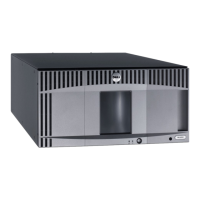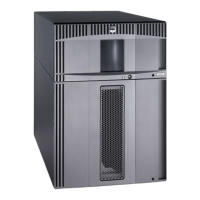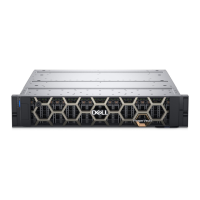Installing, Removing, and Replacing
file:///T|/htdocs/stor-sys/ML6000/en/html/ch08.htm[9/17/2012 1:50:35 PM]
3 Connect the module terminators.
Caution: The module terminator is not the same as a SCSI terminator. Using a SCSI terminator instead of a
module terminator will damage the library.
a Using the module terminators, terminate the top and bottom modules in the library stack. Install one module
terminator in the top terminator connector on the topmost module and one in the bottom terminator connector on
the bottommost module.
If your library configuration consists of a single module, place module terminators in the module's top and bottom
module terminator connectors.
b If you need to add 9U Library Expansion Modules to the 5U Library Control Module, remove the module terminator
from the 5U Library Control Module terminator connection that is closest to the 9U Library Expansion Module.
c Replace the module terminator in the 9U Library Expansion Module terminator connection furthest from the
5U Library Control Module.
4 Connect the module-to-module cable from the 5U Library Control Module to the 9U Library Expansion Module.
5 Connect your Ethernet cable to the Gigabit (GB) Ethernet port on the Library Control Blade (LCB) for remote access to
the library via the Web client.
6 Connect a power cord to the outlet on the power supply on the rear of the library.
There should always be a power cord connected to the power supply on the 5U Library Control Module. If redundant
power supplies are used, connect a power cord to each of the additional power supply outlets.
7 Power on the library.
a Turn on the rear power switch of each of the power supplies.
b Turn on the front power switch.
c Power up the host system.
8 Verify communication with all devices on the bus.
Configure the library using the commands on the operator panel. See configuration information in
Configuring Your Library.
Connecting Library FC Cables to FC I/O Blades
These instructions explain how to install the FC cables that connect the FC drives to the FC I/O blades. The FC I/O blades
support connections to LTO-3, LTO-4, and LTO-5 drives. For information on installing FC I/O blades, see
Adding, Removing,
and Replacing FC I/O Blades.
Cabling may be affected by partitioning or zoning changes made as part of configuration. When cabling to drives, ensure that
they are cabled to the correct hosts for the defined partitions. If the FC I/O blades have active channel zoning, ensure that
the drives are attached to ports that are accessible to defined zone. For information on partitioning, configuring FC I/O blade
ports, channel zoning, and host mapping, see
Configuring Your Library.
Details about cabling FC I/O blades include:
• Each 9U Library Expansion Module can support up to two FC I/O blades. A maximum of four FC I/O blades can be
present in any library configuration. A maximum of four FC drives can be connected to one FC I/O blade.
• Ports 1 and 2 on each FC I/O blade are reserved for connection to hosts. Ports 1 and 2 are always in target mode. The
other four ports (3, 4, 5 and 6) are always in initiator mode. See
Figure 8.
• Ideally, an installed tape drive should be cabled to a port on the nearest FC I/O blade to eliminate the need to manage
excessively long cables. The nearest FC I/O blade is usually located in the same 9U Library Expansion Module as the
tape drive.
Note: See Cable Management Guidelines for best-practice guidelines for cabling a library.
Figure 8 FC I/O Blade

